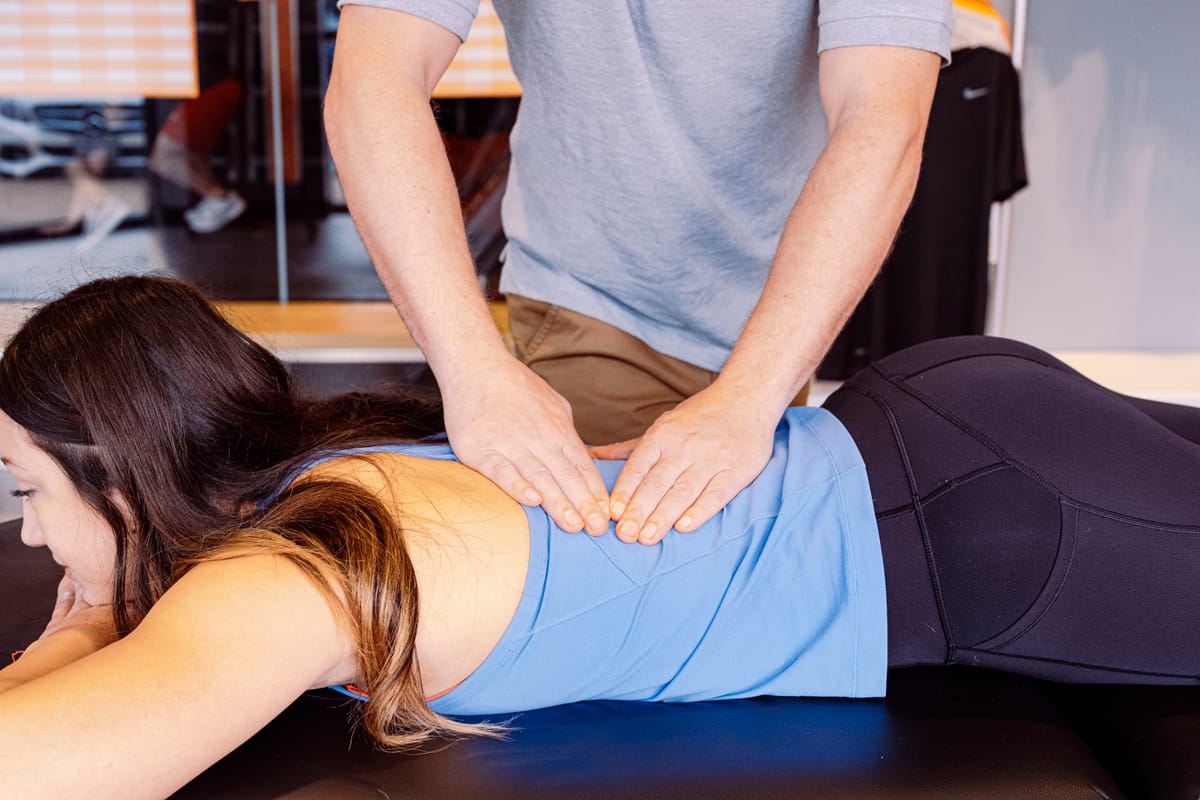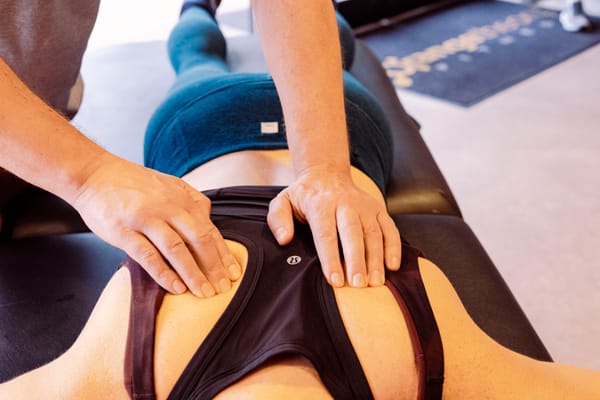
Low Back Pain - Austin, TX
Iler Method® in the Austin area addresses low back pain with specialized trigger point therapy.
What is Low Back Pain?
Low back pain is a common condition characterized by discomfort in the lower portion of the back, ranging from a mild, dull ache to severe, debilitating pain. It can result from various factors, including muscle or ligament strain, disk degeneration, arthritis, or skeletal irregularities. The pain may be acute, lasting a few days to weeks, or chronic, persisting for over three months.
The intensity and nature of low back pain can vary significantly from person to person, and its management often requires a multifaceted approach. Treatment options include manual therapy, medication, exercise, and sometimes surgery for more severe cases.
Preventative measures like maintaining proper posture, engaging in regular physical activity, and using ergonomic tools are vital to avoiding recurrent episodes. Understanding and addressing the underlying cause of low back pain is crucial for effective relief and prevention of future issues.
Iler Method® in the Austin area addresses low back pain with specialized trigger point therapy. Our approach effectively targets the specific muscle groups contributing to discomfort, providing pain relief and improved mobility so clients can return to what they love.
Causes of Low Back Pain
- Overuse: Back muscles through repetitive activities or prolonged physical labor can lead to muscle fatigue and strain, causing low back pain.
- Muscle or Ligament Strain: Repeated heavy lifting or a sudden awkward movement can strain back muscles and spinal ligaments.
- Bulging or Ruptured Disks: When a disc bulges or ruptures, it can press on spinal nerves, including the sciatic nerve, causing back pain. This pressure can lead to muscle strain and disrupt the overall function of the nervous system.
- Arthritis: Osteoarthritis can affect the lower spine, narrowing the space around the spinal cord, a condition known as spinal stenosis.
- Skeletal Irregularities: Conditions like scoliosis, a curvature of the spine, can lead to discomfort and pain in the lower back over time.
- Poor Posture: Chronic poor posture can constantly strain the back muscles and spinal ligaments, causing long-term pain in the lower back.
Symtoms of Low Back Pain
- Muscle Aches: Dull, aching discomfort in the muscles surrounding the lower back, often described as constant muscle soreness.
- Limited Flexibility or Range of Motion: Difficulty bending, twisting, or performing movements that involve the lower back, leading to reduced mobility.
- Pain that Worsens with Certain Activities: Pain intensity increases with lifting, bending, or walking but may be relieved when lying down.
- Numbness or Tingling: Sensations of numbness or tingling in the lower back, buttocks, or legs, often a sign of nerve involvement.
- Muscle Spasms: Sudden, involuntary muscle contractions in the lower back area, causing severe pain and stiffness.
- Radiating Pain to Lower Extremities: Pain that extends from the lower back to the thighs, calves, or feet, often due to sciatica or nerve compression.
- Stiffness in the Morning: Increased back pain and stiffness immediately after waking up may decrease with movement.
How Does Iler Method® Trigger Point Therapy Help Reduce Low Back Pain?
The Iler Method is a trigger point massage therapy that addresses low back pain, a common issue for many in the United States. This method centers around identifying tight muscles in and around the lower back and treating the tiny, hard knots called trigger points.
Trigger points are usually found deep within the muscle tissue and are noticeably firmer than the surrounding areas. They develop as a response to muscle stress and act as a defense mechanism, helping to distribute the stress and prevent muscle overload.
This natural strategy is effective for short-term relief of muscle pain, but it's not a long-term solution because repeated tightening leads to increasingly constricted muscles. Over time, this tightness causes the muscles to exert excessive pull on the joints, leading to further complications.
By directly targeting these trigger points, our method alleviates the immediate discomfort of low back pain and works towards long-term relief with conservative treatments. This lower back pain treatment focuses on the source of your pain, effectively addressing the affected area to provide sustained improvement.
Targeted pressure helps break the pain and muscle tension cycle, promoting healing and preventing future pain episodes. We offer a tailored solution that addresses the root cause of low back pain rather than just providing temporary symptomatic relief.
Trigger Point Techniques for Low Back Pain
Iler Method® trigger point therapy techniques are performed with clients in a prone position without the need for massage oil or lotion. These unique techniques allow therapists to precisely identify and treat deep tissue needs in specific parts of the body, focusing on the cause of your back pain.
This approach ensures clients receive the most effective and consistent bodywork, targeting areas critical for spinal health with non-surgical treatments. Each session is tailored to meet individual client needs, forming part of an individualized treatment plan to restore your ability to perform regular activities.
Elbow -
The elbow, a versatile tool in manual therapy, is particularly effective for addressing low back pain in sore muscles such as the quadratus lumborum, gluteus maximus, minimus, and medius. Its ability to apply a large amount of focused force makes it suitable for reaching deeper connective tissue and adhesions in these posterior muscles. The precision and strength of the elbow allow for intensive work on these dense, often hard-to-reach areas.
However, using the elbow also requires caution due to its potential to cause injury. Therefore, our therapists use their fingers first to locate trigger points, adhesions, and areas of tight tissue. Once these spots are identified, the therapist employs the elbow to perform the more intensive work. This approach ensures a targeted and effective treatment, relieving deep-seated tension and pain while minimizing the risk of harm to the client.
Ridge of the forearm -
In treating lower back pain, the ridge of forearm technique is especially useful for therapists working on muscles like the quadratus lumborum muscle, gluteus maximus, minimus, medius, and the IT band. This technique employs the ulna bone of the forearm, allowing therapists to use their body weight and gravity to exert prolonged, deep pressure on these dense muscle areas. It's ideal for therapists with less arm, shoulder, and chest strength, offering an effective way to reach deeper layers of muscle tissue.
Although this technique might not be the best for identifying specific trigger points or sensing variations in muscle texture, it is highly effective in softening and relaxing the targeted muscles. By applying consistent and deep pressure with the forearm, the therapist can significantly alleviate tightness and stiffness in these key muscle groups, reducing overall pain and improving muscle functionality in the lower back and hip area.
Knuckles -
In treating chronic conditions related to low back pain, a trigger point therapist uses knuckles to apply deep pressure on crucial muscle areas such as the gluteus medius, minimus, maximus, IT band, biceps femoris, and calf muscles. The strength of the knuckles allows for a substantial pressure application, crucial for reaching deep muscle layers and trigger points, often the source of back pain.
This technique is particularly effective in the Iler Method® sessions, known for their static nature. While knuckles may not provide as precise feedback as fingertips, their durability and ability to deliver consistent pressure make them ideal for working on dense muscle groups. This approach helps break down knots and relieve tension, improving overall pain and muscle relaxation.
Final Thoughts: Massage Therapy for Low Back Pain
You don't have to live with low back pain. Iler Method® trigger point therapy in Austin TX, offers a comprehensive and targeted approach to managing and alleviating this common issue. By focusing on deep-set trigger points within the muscle tissue, this therapy provides immediate relief from discomfort and aims at long-term solutions to prevent chronic pain. Specialized techniques such as the elbow, ridge of the forearm, and knuckles enhance the effectiveness of the treatment, ensuring deep tissue manipulation that addresses the root causes of pain.
Our commitment to providing tailored, focused care through the Iler Method empowers clients to regain control over their body's functionality and pain management. By breaking the cycle of muscle tension and promoting healing, we help clients achieve lasting relief and an improved quality of life. This personalized approach underscores our dedication to treating symptoms, fostering a holistic recovery, and maintaining back health.
Massage for Low Back Pain: FAQs
Should I get a massage if my lower back hurts?
Yes, for those experiencing lower back pain, receiving a massage that incorporates trigger point therapy from a licensed massage therapist is advisable, as this specialized approach targets muscle knots and areas of tension, effectively alleviating pain, enhancing mobility, and improving muscle function, particularly beneficial for chronic pain or tension-related discomfort.
What type of massage is best for lower back pain?
Trigger point therapy, explicitly targeting muscle knots and tension areas, is widely regarded as the best type of massage for alleviating lower back pain. It offers targeted relief and improved muscle function compared to other treatment options.
What are the disadvantages of massage for back pain?
While general massage sessions can provide temporary relief, they may not effectively address the root causes of back pain. Trigger point therapy is a superior option because it takes a targeted approach to identify and treating specific areas of muscle tension and knots.




